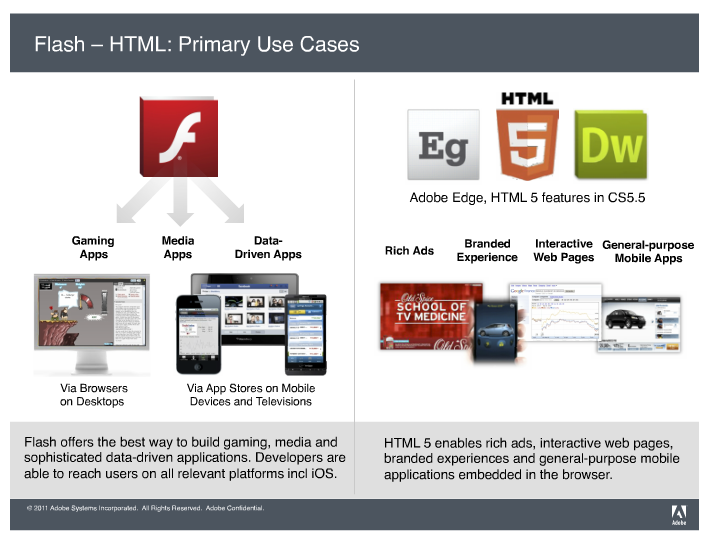Adobe launches Flash Player 11 over concerns about its future

Adobe on Wednesday will launch its Flash Player 11 for general consumption as it works to bolster adoption even as key partners move toward HTML 5 and browser technologies that don't require plug-ins.
The company considers Flash Player 11 and its Adobe AIR 3 to be milestone releases that will enable 3D games, enhance the user experience and improve video delivery. Adobe aims to have 1 billion devices support AIR by the end of 2015.
In an interview, Anup Murarka, director of product marketing for Adobe Flash, had two missions. First, he had to counter the perception that Flash was fading. Murarka also had to address Microsoft's decision to go plug-in free---and therefore without Flash---on its Metro IE 10 browser. Apple's feelings---or lack of them---about Flash have been known for years.
Adobe's point is that Flash and HTML 5 will run side by side for years to come.
"We are going to keep the pace of innovation on Flash," said Murarka. "Microsoft was clear that the use case for Flash is on the desktop. Flash will run just fine on the Windows desktop."
Murarka also moved to combat the perception that Flash usage was dropping. The overall market for mobile video and applications is booming and Flash is riding along.
It's also worth noting that Flash isn't a moneymaker for Adobe, which sells developer tools. "There's a chain of value in the tools, servers and analytics to enable mobile apps," he said. Of course, Adobe is "always worried about developer interest," but the idea "that Flash is getting less popular is nothing that any of our metrics are showing."
With that backdrop, Adobe launched its Flash Player 11 and AIR 3 software. The goal appears to be to do things that HTML 5 can't quite do yet. Adobe sees its Flash and AIR platforms as ways to create content and applications across multiple platforms---Android, BlackBerry, Mac, Windows---and screens---smartphones, PCs and TVs.
Indeed, Adobe does address some key holes with its latest Flash Player and AIR releases. Among the key items:
- Native extensions that allow developers to tap into hardware features such as light sensors, dual screens and Near Field Communications (NFC).
- Captive runtime so developers can package AIR 3 with applications. That move will simplify installations on Android, Windows, Mac and Apple's iOS. On many platforms, a user would have to download AIR separately to run an app.
- Content protection that enables services like TV Everywhere as well as rental and subscription support.
- Improved video and 2D/3D support.
Related:
- Adobe's potential enterprise worries trump Flash concerns
- Adobe CEO: Tablets will be more than consumption devices
- Windows 8: Adobe sees Flash in the future of the Metro UI
- CNET: Microsoft joins anti-Flash crowd with IE10
- CNET: Adobe: Flash will flourish despite Windows 8
- Microsoft: Metro style browsing and plug-in free HTML
- Calm down, Windows 8 DOES support Flash
